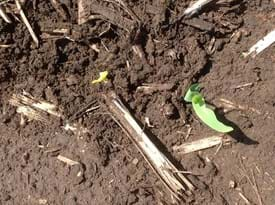Agronomy Update: Planters Ready To Roll
BY DAIRYLAND SEED AGRONOMY TEAM
Emergence as a Corn Yield Factor: Ears per Acre
If planting a new crop of corn renews our hopes, seeing it emerge renews our spirits. That first field of corn we can ‘row’ from the truck, light green against the morning sun, shoots more energy into our veins than any mug of coffee. Nostalgia aside, when you can ‘row’ corn from the road, we are already past the first factor in the yield equation: the number of ears per acre. Field prep, planter prep and planting conditions play important roles into getting us this far, but what are the warning signs that we should we watch for to ensure all of this was properly executed?
Since we are still at the front end of planting season, it’s worth mentioning that patience with field conditions is critical. This is especially important in 2020 since many producers are challenged with repairing fields that were left in disrepair following a wet 2019. Without proper attention, expect to see cloddy soil that will prevent adequate seed to soil contact and hurt emergence. Watch these areas carefully throughout the early season: your best efforts may not eliminate the problems.
|
Wet conditions at planting (or pounding rain immediately following planting) can create surface compaction/crust, thus resulting in poor emergence. If you suspect crusting, scout fields as the crop approaches the ~125 GDUs it takes for corn to emerge. Dust off the rotary hoe if you see a good amount (~10% or more) of plants starting to leaf-out under the surface (see photo). Side-wall compaction can also be a result of wet planting conditions. Many times, this will only become obvious after the corn is knee high, when the restrictions to root growth become the lead limiting factor in plant growth. There is little that can be done to alleviate the problem at this point, so it takes proper actions (or inactions) ahead of time. |
|
Other emergence related topics can be found throughout the Dairyland Seed Agronomy newsletters. Note articles about early season pests and the effects of cold soils on emergence.
Those First Couple of Hours of Planting
Planting has already begun in a few places, so this may be a bit late for you. However, for most growers, planting is just about to begin. Here are a few notes for those first couple of hours in the field.
- Plan on spending most of the first two or three hours of planting out of the tractor and behind the planter. I know, you are eager to go and you fine-tuned the planter in the shed last month. But, there is no substitute for time on your knees behind the planter carefully checking seeding depth, seed spacing, seed placement, and soil firming around the seed. You have one chance to get this right, and it can pay dividends all season long.
- Depth: Is the depth where you want it, and is it consistent from seed to seed and from row to row? I like 1.5 inches of depth for corn for most conditions, but consistency from seed to seed is more important than actual depth.
- Seed spacing: Monitors are great and do a nice job of measuring and recording spacing. However, “ground truth” – literally - to make sure the monitor is accurately measuring seed placement. Uncover a few three-foot sections of row to carefully look at spacing between seeds. Is it what you want?
- Seed placement: Is the seed placed in the bottom of the seed furrow? Consistently?
- Soil firming: Is the soil nicely firmed around the seed? Closing wheel type and down pressure can make big differences. Soil nicely firmed around the seed will enable consistent water imbibition, germination, and emergence.
- Check every row on the planter. Don’t just assume that because the settings are the same that each row unit is doing the same thing.
- Now move to another part of the field – another soil type, another area – check again. Recheck for every soil type in the field, and adjust as best you can to maximize planter performance in each soil type.
By carefully checking actual activity of the planter in that first few hours in the field, you give yourself the best chance for success for the crop. An extra hour or two early on is well worth the effort.
Insect Trap Counts Have Been High Recently
Insect pheromone traps are indicating heavy migration of true armyworm and black cutworm adults into the Midwest. They have hitched a ride from the southern states by riding on weather systems and getting dumped off to begin their life cycle in the Midwest. Due to the recent cold snap, however, we are not too alarmed at this time. But, when the weather warms they resume their mission with new flights from the south. Trapping in the southern most area of the Dairyland Seed footprint (thanks to Purdue University and our very own, Dan Ritter) is an aid in determining the potential of insect activity in northern and eastern areas in the near future. Many fields did not receive a fall herbicide or a spring burndown yet, therefore providing plenty of egg laying sites. I have seen a lot of chickweed on many fields!
Migrating black cutworm moths are attracted to fields with significant coverage of winter annuals, particularly broadleaf weeds such as chickweed. Moths lay the eggs on these weeds in the spring. Fields with an infestation of chickweed should plan on planting insect traited corn that controls black cutworm or scout fields regularly through V6 for black cutworm damage. Their favorite weed for egg laying is chickweed and there is plenty of that around this year. Black cutworms could be a problem in both corn and soybeans if weeds are burned down after egg laying and the only meal available is corn or soybeans after they hatch.
True armyworm adults will lay eggs in small grains including cereal rye cover crop. Corn planted into rye cover crop should be scouted regularly for true armyworm feeding. In addition, any corn planted next to rye or wheat should be scouted for true armyworm feeding as the wheat or rye matures. True armyworm will leave maturing wheat or rye and migrate to neighboring corn fields. True armyworm infestations may consume a lot of corn very quickly -- scouting is essential. Meanwhile wheat must be scouted for true armyworm feeding. True armyworm may cause heavy economic damage to wheat also.
With high trap counts and some weedy fields, we think it will be likely for susceptible fields to see infestations of these pests somewhere. Scout!
Give us a call as you get the planters rolling. Stay safe this spring.
Early Weed Control for Alfalfa
Some producers have been fortunate enough to seed alfalfa while others soon will. Listed below are a few items to think about
Weed Control: A thick healthy stand and canopy help control weeds. This, coupled with either pre and or post emerge herbicides, can help produce a cleaner, weed free stand, that produces a higher Relative Feed Value (RFV). Post emerge herbicides often require very specific timing: commonly V2-3 alfalfa and weeds that are 1-2 inches tall. Keep a close eye on those alfalfa seedlings and plan accordingly. Remember, weeds are taking water and nutrients away from alfalfa plants and decreasing the stand longevity. Controlling weeds early helps create a better Return on Investment (ROI).
Delay First Cutting: By delaying the first cutting until the alfalfa plant has been able to hit full flower or shortly thereafter, you are allowing the alfalfa plant the opportunity to establish its tap root system and also start storing carbohydrates within the plant. By waiting to cut, you improve the potential for increased stand longevity.
Insects and Disease: Insects like Potato Leafhopper and Alfalfa Weevil can have a horrific impact on alfalfa seedlings. Monitoring these insect levels and utilizing proper Integrated Pest Management (IPM) to control these pests will increase seedling health, crop quality as well as having an impact on stand longevity.
Diseases such as Common Leaf Spot, Spring Black Stem and Leaf Spot as well as a host of others diseases can have detrimental effects on an alfalfa stand, especially seedlings. Due to the fact that your cutting timing is extended on a new seeding, these diseases have a longer time frame to affect plants and an application of a quality fungicide is strongly suggested to help control the disease(s) and offer better plant health to the alfalfa plant. In other field crops, root systems have shown a slight increase in size. If this follows suit into alfalfa, it may also help with creating a more vibrant and healthier tap root.
Soil Fertility and pH: Alfalfa produces best on soils with a pH of 6.8-7.0 and higher fertility levels. Post-harvest fertilizer and lime applications are often necessary to maintain high output stands. Applications after first and third cuttings can be an effective strategy depending on the demands of your crop.
Corteva Technology Use Agreements
All growers with orders for any Corteva Agriscience brand seed product, regardless of crop or trait (including non-GM products) need to have a signed Corteva Technology Use Agreement in place by September 1. Growers should sign the Corteva Technology Use Agreement electronically at www.agcelerate.com. Signing electronically is preferable, however, paper copies are available at www.traitstewardship.com.
 |
 |
 |
 |
 |
| Brian Weller Western Region 507.456.3034 |
Dan Ritter Central Region 219.863.0583 |
Branden Furseth Northern Region 608.513.4265 |
Rod King Eastern Region 574.596.6721 |
Terry Jones Eastern Region 419.630.3115 |

